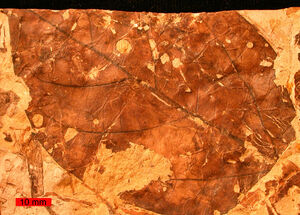
A fossil Viburnum lesquereuxii leaf with evidence of insect herbivory; Dakota Sandstone (Cretaceous) of Ellsworth County, Kansas. Scale bar is 10 mm.
Herbivory is a form of predation in which an organism, known as a herbivore, consumes principally autotrophs[1] such as plants, algae and photosynthesizing bacteria. By that definition, many fungi, some bacteria, many animals, some protists and a small number of parasitic plants can be considered herbivores. However, herbivory is generally restricted to animals eating plants. Fungi, bacteria and protists that feed on living plants are usually termed plant pathogens. Microbes that feed on dead plants are saprotrophs. Flowering plants that obtain nutrition from other living plants are usually termed parasitic plants. More generally, organisms that feed on autotrophs in general are known as primary consumers.
Evolution of herbivory[]
Our understanding of herbivory in geological time comes from three sources: fossilized plants, which may preserve evidence of defence (such as spines), or herbivory-related damage; the observation of plant debris in fossilised animal faeces; and the construction of herbivore mouthparts.[2]
Long thought to be a Mesozoic phenomenon, evidence for herbivory is found almost as soon as fossils which could show it. Within under 20 million years of the first fossils of sporangia and stems towards the close of the Silurian, around , there is evidence that they were being consumed.[3] Animals fed on the spores of early Devonian plants, and the Rhynie chert also provides evidence that organisms fed on plants using a "pierce and suck" technique.[2]
During the ensuing 75 million years[citation needed], plants evolved a range of more complex organs - from roots to seeds. There is no evidence for these being fed upon until the middle-late Mississippian, . There was a gap of 50 to 100 million years between each organ evolving, and it being fed upon; this may be due to the low levels of O2 during this period, which may have suppressed evolution.[3] Further than their arthropod status, the identity of these early herbivores is uncertain.[3] Hole feeding and skeletonization are recorded in the early Permian, with surface fluid feeding evolving by the end of that period.[2]
Arthropods have evolved herbivory in four phases, changing their approach to herbivory in response to changing plant communities.[4]
Another stage of herbivore evolution is characterized by the evolution of tetrapod herbivores, with the first appearance in the fossil record near the Permio-Carboniferous boundary approximately 300 MYA. The earliest evidence of herbivory by tetrapod organisms is seen in fossils of jawbones where dental occlusion (process by which teeth from the upper jaw come in contact with those in the lower jaw) is present. The evolution of dental occlusion lead to a drastic increase in food processing associated with herbivory and provides direct evidence about feeding strategies based on tooth wear patterns. Examination of phylogenetic frameworks reveals that dental occlusion developed independently in several lineages through dental and mandibular morphologes, suggesting that the evolution and radiation of tetrapod herbivores occurred simultaneously within various lineages. [5]
See also[]
References[]
- ^ Campbell, N. A. (1996) Biology (4th edition) Benjamin Cummings, New York ISBN 0-8053-1957-3
- ^ a b c Labandeira, C.C. (1998). "Early History Of Arthropod And Vascular Plant Associations 1". Annual Reviews in Earth and Planetary Sciences 26 (1): 329–377. doi:.
- ^ a b c Labandeira, C. (2007). "The origin of herbivory on land: Initial patterns of plant tissue consumption by arthropods". Insect Science 14 (4): 259–275. doi:.
- ^ Labandeira, C.C. (2005). "The four phases of plant-arthropod associations in deep time" (Free full text). Geologica Acta 4 (4): 409–438. http://www.geologica-acta.com:8080/geoacta/pdf/vol0404a01.pdf. Retrieved on 2008-05-15.
- ^ Origin of dental occlusion in tetrapods: signal for terrestrial vertebrate evolution? Journal of Experimental Zoology Part B: Molecular and Developmental Evolution. Volume 306B Issue 3, Pages 261 - 277 Special Issue: Vertebrate Dentitions: Genes, Development and Evolution Published Online: 8 May 2006 Copyright © 2008 Wiley-Liss, Inc., A Wiley Company Robert R. Reisz * Department of Biology, University of Toronto at Mississauga, Mississauga, Ont., Canada L5L 1C6
Further reading[]
- Bob Strauss, 2008, Herbivorous Dinosaurs, The New York Times